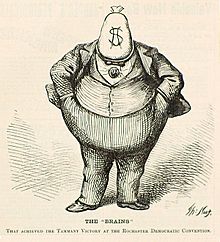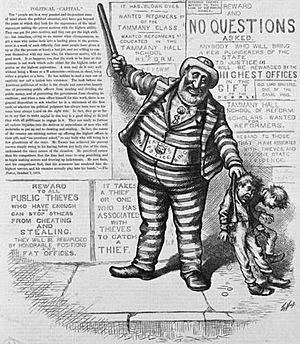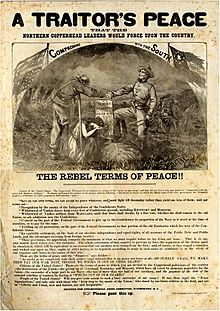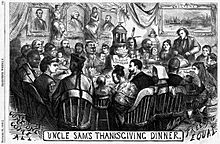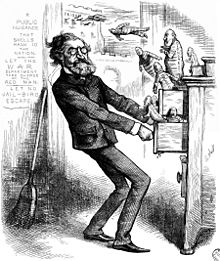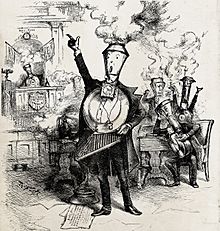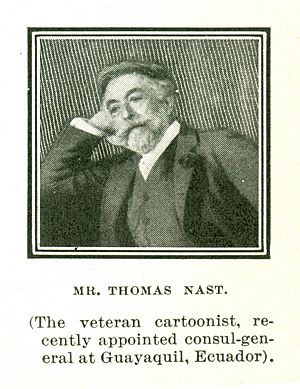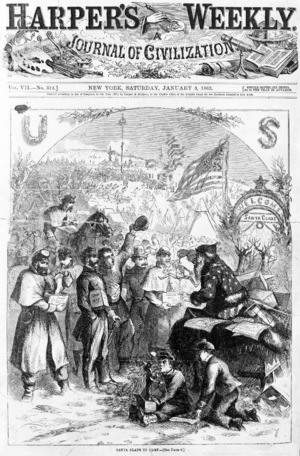Thomas Nast facts for kids
Quick facts for kids
Thomas Nast
|
|
|---|---|
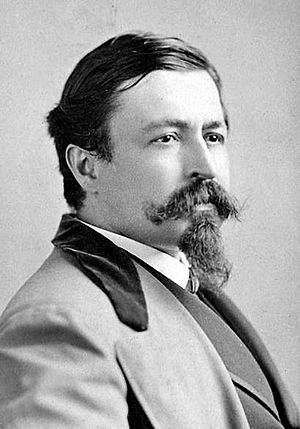
Photograph of Nast by Napoleon Sarony, taken in Union Square, New York City
|
|
| Born | September 26, 1840 |
| Died | December 7, 1902 (aged 62) |
| Political party | Republican |
| Signature | |
 |
|
Thomas Nast (born September 26, 1840 – died December 7, 1902) was a famous German-born American caricaturist and editorial cartoonist. Many people call him the "Father of the American Cartoon."
He was well-known for criticizing "Boss" Tweed and his powerful political group, Tammany Hall. Nast helped create the modern look of Santa Claus. He also gave the Republican Party its elephant symbol. While he made Uncle Sam and the Democratic donkey very popular, he did not invent them. Nast worked for Harper's Weekly magazine for many years. President Theodore Roosevelt once said, "Thomas Nast was our best teacher."
Contents
Early Life and Artistic Beginnings
Nast was born in Landau, Germany. His father was a musician in the army. In 1846, his family moved to New York City. Thomas was six years old when they arrived.
He went to school in New York City until he was 14. He wasn't very good at school subjects. But he loved to draw from a young age. In 1854, he studied art for about a year. He then went to the National Academy of Design school.
In 1856, he started working as a draftsman for Frank Leslie's Illustrated Newspaper. His first drawings for Harper's Weekly appeared in 1859. He was 18 years old. These drawings showed police corruption.
Nast's Amazing Career
In 1860, Nast traveled to England. He drew a big boxing match for a newspaper. A few months later, he went to Italy. He joined Giuseppe Garibaldi, a famous Italian leader. Nast's drawings and stories about Garibaldi's fight to unite Italy became very popular in the U.S.
He returned to New York in 1861. That same year, he married Sarah Edwards. In 1862, he started working for Harper's Weekly again.
During the American Civil War, Nast became famous for his emotional drawings. One famous drawing was "Christmas Eve" (1862). It showed a soldier's family at home and the soldier far away. Another important cartoon was "Compromise with the South" (1864). It was against people who wanted to stop the war. President Abraham Lincoln called Nast "our best recruiting sergeant." This meant Nast's drawings helped people join the army.
After the war, Nast strongly disagreed with President Andrew Johnson. Johnson's policies were against rebuilding the South. Nast drew many strong cartoons against him. This was the start of Nast's great work as a caricaturist.
Nast's Drawing Style and Important Ideas
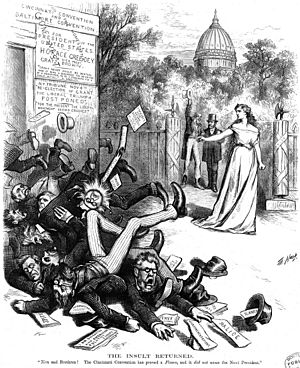
Nast's early cartoons often had many small scenes. They told detailed stories. After 1870, his drawings became simpler. They focused on one strong main image. He often used photographs to make his drawings look like real people.
Nast was against the Catholic Church. He believed it was a threat to American values. He was especially against Catholic ideas in public schools. In 1871, he drew "The American River Ganges." It showed Catholic bishops as crocodiles attacking school children. He thought public money for religious schools was bad for democracy.
Nast also showed negative ideas about Irish immigrants. He drew them as violent and easily controlled by politicians. He saw them as a symbol of mob violence. This might have come from things he saw when he was young. In 1863, he saw the New York City draft riots. Many Irish immigrants were involved in burning down an orphanage for Black children.
However, Nast also supported other minority groups. He supported Native Americans and Chinese Americans. He was against slavery and racial segregation. He also spoke out against the violence of the Ku Klux Klan.
Fighting "Boss" Tweed
Boss Tweed drawn by Thomas Nast in 1871.
Nast's drawings were very important in bringing down Boss Tweed. Tweed was a powerful leader in New York City. He and his group stole millions of dollars from the city. They did this by making up huge expenses for projects.
Nast had drawn cartoons against Tweed since 1867. But in 1870 and 1871, he focused even more on Tweed and his friends. Tweed was so afraid of Nast's cartoons that he offered him a bribe. Tweed offered Nast $500,000 to stop drawing. But Nast refused. He said he wanted to put those people in jail.
Nast kept attacking Tweed in Harper's Weekly. Because of his work, Tweed's group lost power in the election of November 1871. Tweed was arrested in 1873. When Tweed tried to escape to Spain, officials recognized him from one of Nast's cartoons.
Nast's Influence in Politics
Nast was the first journalist who didn't own a newspaper to greatly influence public opinion. His cartoons helped decide five presidential elections. These included Abraham Lincoln (1864), Ulysses S. Grant (1868 and 1872), Rutherford B. Hayes (1876), and Grover Cleveland (1884).
His cartoons made fun of the losing candidates. Nast's influence was huge because he had little competition. Also, Harper's Weekly was very strong and popular. Its circulation reached up to 300,000 copies. With people sharing the magazine, Nast's audience was over a million.
One of his most important cartoons was "Compromise with the South." It appeared in Harper's Weekly in 1864. It showed Jefferson Davis, the Confederate leader, shaking hands with a crippled Union soldier. The cartoon showed the serious issues of the election. Lincoln's campaign used this cartoon as posters. It was very effective in helping Lincoln win.
In 1868, Nast played a big role in Ulysses S. Grant's presidential win. Grant himself said Nast's "pencil" helped him win. Nast became a close friend of President Grant.
Nast was a strong Republican for many years. He helped Rutherford B. Hayes win the 1876 election. But Nast soon became unhappy with Hayes's policies.
After 1877, Nast's cartoons appeared less often in Harper's. He and his editor, George William Curtis, often disagreed. Curtis thought cartoons should only attack the opposing party. Nast believed in hitting the "enemy between the eyes."
Between 1877 and 1884, Nast's work was less frequent. He also drew many cartoons supporting Chinese immigrants. He criticized Senator James G. Blaine for supporting the Chinese Exclusion Act. Nast was one of the few artists who stood up for Chinese people in America.
In 1884, Nast and Curtis both supported the Democratic candidate, Grover Cleveland. Cleveland wanted to reform government jobs. Nast's cartoons helped Cleveland become the first Democrat president since 1856. Many people believed Nast's support helped Cleveland win by a small amount.
Nast stopped working for Harper's Weekly in December 1886. It was said that Nast lost his main platform. Harper's Weekly also lost some of its political power without him.
Later Life and Passing
Nast lost most of his money in 1884. He had invested in a company run by a swindler. To earn money, he went on lecture tours in 1884 and 1887.
In 1890, he published Thomas Nast's Christmas Drawings for the Human Race. He drew cartoons for other magazines. But he couldn't get back his earlier fame. His style of cartooning was seen as old-fashioned. He also had pain in his hands, which made drawing harder.
In 1892, he took over a struggling magazine. He renamed it Nast's Weekly. He used it to support Benjamin Harrison for president. But the magazine did not do well. It closed after seven months.
Nast had little money left. In 1902, he asked for a job with the government. President Theodore Roosevelt admired Nast. He offered him a job as the U.S. Consul General in Guayaquil, Ecuador. Nast accepted and went to Ecuador in July 1902.
During a yellow fever outbreak, Nast stayed to help people. He caught the disease himself. He died on December 7, 1902. His body was brought back to the United States. He was buried in Woodlawn Cemetery in The Bronx, New York City.
Nast's Lasting Legacy
Nast's drawings of famous characters are still used today. These include:
- The modern look of Santa Claus.
- The Republican Party elephant.
- The Democratic Party donkey (he made it popular).
- The Tammany Hall tiger, a symbol for Boss Tweed.
- The lanky Uncle Sam (he added the goatee).
In 2011, there was a discussion about putting Nast in the New Jersey Hall of Fame. Some people objected because of his old cartoons. These cartoons showed negative stereotypes of Irish people.
Thomas Nast Award
The Thomas Nast Award was given each year since 1968. The Overseas Press Club gave it to cartoonists for their international work. But in 2018, the club removed Nast's name from the award. They said his drawings showed "ugly bias against immigrants, the Irish and Catholics."
Thomas Nast Prize
The Thomas Nast Prize is given by the Thomas Nast Foundation. This foundation is in Nast's birthplace in Landau, Germany. It has been given since 1978. The prize goes to one German and one North American cartoonist. Winners receive money and a trip to Landau.
"Nasty" Word Origin
Some people mistakenly think the word "nasty" comes from Nast's name. They think this because his cartoons were sometimes harsh. But the word "nasty" is much older. It has been used since the 1400s. Its true origin is not clear.
Images for kids
-
September 1868 Nast cartoon "This is a White Man's Government!" showing a stereotyped Irishman, an ex-Confederate soldier, and Democratic party chairman August Belmont "triumphing" over a prostrate USCT soldier.
-
1871 Nast cartoon: "Move on! Has the Native American no rights that the naturalized American is bound to respect?" (while naturalized foreigners had the vote, Native Americans had no vote, as they were not considered United States citizens, which was not remedied until 1924.)
-
Nast's cartoon "Third Term Panic." It shows the Democratic donkey panicking other political animals, including a Republican Party elephant.
See also
 In Spanish: Thomas Nast para niños
In Spanish: Thomas Nast para niños





